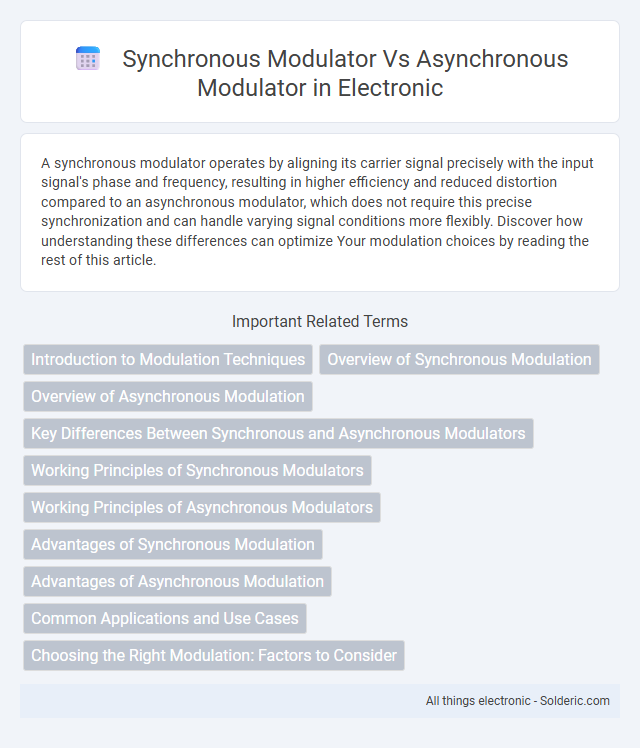A synchronous modulator operates by aligning its carrier signal precisely with the input signal's phase and frequency, resulting in higher efficiency and reduced distortion compared to an asynchronous modulator, which does not require this precise synchronization and can handle varying signal conditions more flexibly. Discover how understanding these differences can optimize Your modulation choices by reading the rest of this article.
Comparison Table
| Feature | Synchronous Modulator | Asynchronous Modulator |
|---|---|---|
| Operation | Modulation synchronized with input signal carrier | Modulation operates independent of input signal carrier |
| Carrier Signal | Uses fixed carrier frequency aligned with input | Carrier frequency can vary or be free-running |
| Signal Quality | Higher fidelity and reduced distortion | Potentially higher phase noise and distortion |
| Complexity | More complex circuitry due to synchronization | Simpler design with less synchronization requirements |
| Applications | High-quality communication systems, precise waveform generation | Low-cost modulators, simple communication links |
| Latency | Lower latency due to direct carrier sync | Higher latency possible due to asynchronous operation |
Introduction to Modulation Techniques
Synchronous modulators generate carrier signals that are phase-locked to the input signal, enabling precise modulation and improved signal fidelity in communication systems. Asynchronous modulators operate without a fixed phase relationship to the input, resulting in simpler designs but potentially increased distortion and noise. Understanding the trade-offs between synchronous and asynchronous modulation techniques is critical for optimizing performance in digital and analog communication applications.
Overview of Synchronous Modulation
Synchronous modulation involves aligning the modulating signal's phase and frequency with the carrier signal to achieve precise signal control, enhancing the efficiency and performance of communication systems. This technique ensures that your transmitted signal maintains phase coherence, reducing distortion and improving signal clarity compared to asynchronous modulators, which operate without such alignment. In applications where timing and synchronization are critical, synchronous modulators offer superior accuracy and reliability in data transmission.
Overview of Asynchronous Modulation
Asynchronous modulation operates without a shared clock signal between the transmitter and receiver, enabling more flexible timing and reducing synchronization requirements. It often uses start and stop bits to indicate the beginning and end of data transmission, making it suitable for intermittent or burst data flows. This modulation method supports variable data rates and simpler hardware, contrasting with synchronous modulation's continuous clock alignment and higher efficiency in steady data streams.
Key Differences Between Synchronous and Asynchronous Modulators
Synchronous modulators operate by aligning the modulation signal with a reference clock, ensuring precise timing and phase synchronization, which enhances signal fidelity and reduces error rates. Asynchronous modulators, in contrast, allow modulation without a common clock reference, resulting in timing variations and potential phase discrepancies, leading to increased jitter and less predictable signal behavior. The key differences lie in timing control, synchronization accuracy, and the impact on signal integrity, with synchronous modulation preferred for high-performance communication systems requiring tight timing precision.
Working Principles of Synchronous Modulators
Synchronous modulators operate by mixing the input signal with a reference carrier signal that is phase-locked to the input, achieving precise phase and frequency alignment. This synchronization enables high fidelity modulation with reduced distortion and improved spectral efficiency compared to asynchronous modulators, which do not rely on phase alignment and typically use free-running oscillators. The working principle of synchronous modulators centers on coherent detection, allowing accurate carrier recovery and enabling complex modulation schemes like QAM (Quadrature Amplitude Modulation) with enhanced signal integrity.
Working Principles of Asynchronous Modulators
Asynchronous modulators operate by encoding information without relying on a fixed clock signal, allowing data transmission to occur at irregular intervals based on the input signal's timing. These modulators utilize techniques such as pulse position modulation (PPM) or pulse width modulation (PWM) where the timing or duration of pulses directly represents the encoded data. This approach provides flexibility in handling variable data rates and reduces synchronization complexity compared to synchronous modulators, which require strict timing alignment between transmitter and receiver.
Advantages of Synchronous Modulation
Synchronous modulation offers enhanced signal accuracy and reduced distortion by precisely aligning the carrier and message signals, which improves overall communication quality. This technique enables better noise immunity and higher data rates compared to asynchronous modulation, making it ideal for complex systems requiring reliable transmission. Your communication system benefits from increased spectral efficiency and improved synchronization, crucial for advanced digital applications.
Advantages of Asynchronous Modulation
Asynchronous modulation offers significant advantages such as simpler transmitter design and reduced synchronization requirements, which enhance system flexibility and ease of implementation. It enables your communication system to handle variable data rates more efficiently, accommodating diverse signal conditions without strict timing constraints. This approach also improves robustness against timing jitter and clock drift, ensuring more reliable data transmission in dynamic environments.
Common Applications and Use Cases
Synchronous modulators are commonly used in applications requiring precise phase alignment and low distortion, such as communication systems, radar signal processing, and high-fidelity audio transmission. Asynchronous modulators find their use in simpler, cost-sensitive devices like basic data communication, wireless sensor networks, and non-critical remote controls, where strict timing is less crucial. Your choice between these modulators depends on the need for timing accuracy and signal integrity in your specific application.
Choosing the Right Modulation: Factors to Consider
Choosing the right modulation between synchronous and asynchronous modulators depends on factors like signal quality, power consumption, and application requirements. Synchronous modulators offer precise timing control and lower error rates, ideal for high-fidelity communication systems, while asynchronous modulators provide simpler design and are better suited for systems with variable data rates or timing variations. Understanding your system's tolerance for latency, signal jitter, and complexity will guide your choice for optimal performance.
Synchronous modulator vs asynchronous modulator Infographic

 solderic.com
solderic.com